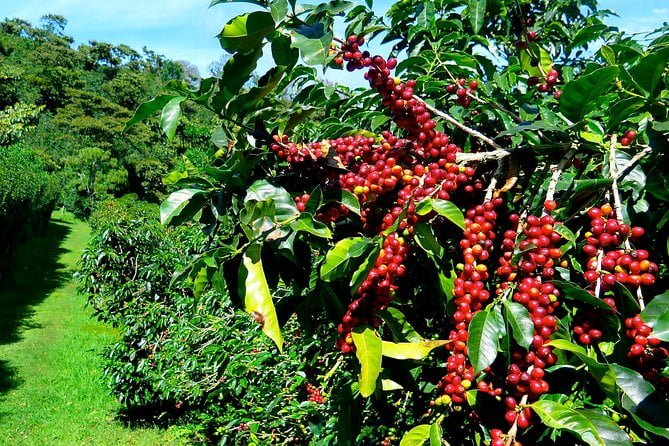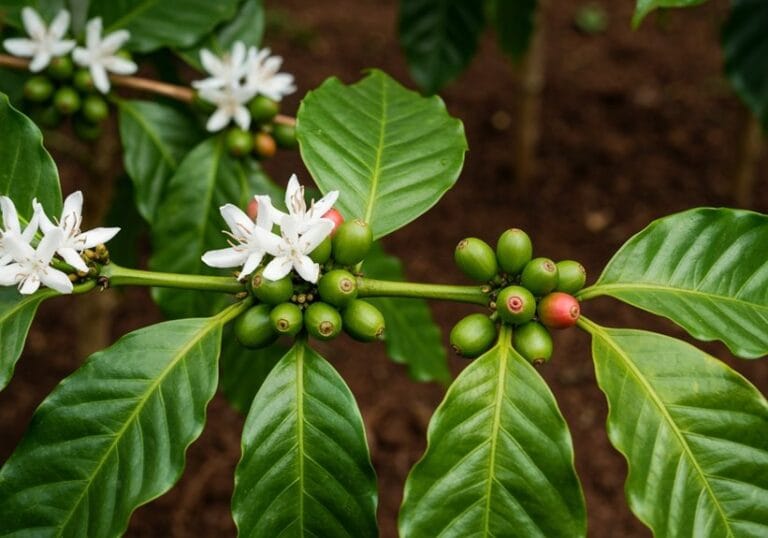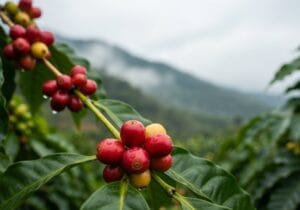The coffee bean plant, scientifically known as Coffea arabica, is a real wonder! It’s not just a pretty face with those elliptical leaves. Nope! This bush can grow 4 to 10 meters tall—talk about ambition! It thrives in that magical Coffee Belt with rich, well-drained soil and a humidity-hugging atmosphere. Now, who knew these plants are like Goldilocks, needing conditions that are “just right”? Plus, the flavor can really surprise you—sometimes, it’s like the beans have moods! Stick around for more juicy coffee secrets!
Key Takeaways
- Coffee bean plants belong to the Coffea arabica species and have 44 chromosomes, making them an allotetraploid.
- They thrive in the Coffee Belt, requiring a humidity-rich climate and well-drained, nutrient-rich soil.
- Arabica coffee prefers cooler altitudes between 1,200-1,800 meters, while Robusta thrives in warmer conditions.
- Coffee plants produce white flowers that develop into coffee cherries, crucial for bean production.
- Environmental factors and careful plant care significantly influence coffee flavor profiles and yield stability.
Botanical Classification and Genetic Features
When you take a moment to sip your morning coffee, it’s easy to overlook the incredible journey this humble beverage makes, starting from its botanical roots.
Believe it or not, coffee is a plant—a real diva of the plant world! Let’s talk about the Coffea arabica! This little superstar is classified in the Rubiaceae family and is an allotetraploid, sporting 44 chromosomes. I mean, talk about a genetic overachiever! Robusta coffee, in contrast, exhibits high genetic diversity**, showcasing various subtypes like Conilon and Nganda. Natural mutations** form the basis for classifying certain coffee varieties, highlighting the evolution of flavors through genetic adaptations.
Now, regarding coffee arabica plant care, it’s all about balancing light and love (and maybe a bit of water). The genetic diversity in arabica coffee tree care creates flavors that can surprise your taste buds, making you wonder who did the brewing! Did you know that Coffea arabica accounts for 60% of global coffee production?
And who doesn’t love a good plot twist in each cup?
Physical Morphology and Growth Requirements
As the coffee plant evolves and grows, it showcases an impressive array of physical characteristics—think of it like a plant strutting its stuff on a runway! The coffee bush can reach heights of 4 to 10 meters, depending on the type and conditions. Its leaves are the real show-stoppers, growing in pairs like synchronized swimmers, and they love playing tag with the wind!
Here’s a quick breakdown of its fabulous features:
| Feature | Description | Importance |
|---|---|---|
| Leaf Shape | Elliptical and lanceolate | Aesthetics & photosynthesis |
| Root System | Varies by species, shallow to deep | Nutrient uptake & drought tolerance |
| Flowering | White flowers leading to coffee cherries | Fruit production |
Environmental Preferences and Economic Significance

The coffee plant isn’t just a pretty face on the block; it has some deep-seated preferences that really determine whether it thrives or just gives up and wilts in despair!
The coffee plant demands the perfect conditions to flourish, or it’s curtains for our beloved brew!
Ideal coffee plant coffee conditions are found in the tropics, specifically in the magical Coffee Belt where coffee beans grow like they own the place, needing a humidity-hugging climate and rich, well-drained soil.
Imagine this: Arabica coffee likes it cool, while Robusta prefers to crank up the heat! Arabica coffee grows optimally at altitudes of 1,200-1,800 meters, which adds an additional layer of complexity to its cultivation requirements.
This isn’t just about high-altitude flair—there’s serious economic significance here, folks!
With over 70 countries in the coffee game, global production relies on keeping these delicate plants happy. Additionally, changes in climate patterns threaten the stability of coffee yields, making it vital to adapt farming practices to ensure a sustainable supply.
Frequently Asked Questions
How Long Does It Take for Coffee Cherries to Ripen?
Coffee cherries typically take 7 to 8 months to ripen after flowering, with Arabica varieties maturing in 7 to 9 months, while Robusta may require 9 to 11 months, depending on environmental factors.
What Pests Commonly Affect Coffee Plants?
Common pests that affect coffee plants include the Coffee Berry Borer, Coffee Leaf Miner, Mealybugs, Scale Insects, and nematodes. Each pest poses significant threats, leading to yield reduction and compromised coffee quality.
Can Coffee Plants Be Grown Indoors?
Yes, coffee plants can be grown indoors. They thrive in bright, indirect sunlight, require consistent moisture, and prefer stable temperatures with high humidity. Proper care can support their healthy growth and development in indoor environments.
How Do I Propagate a Coffee Bean Plant?
To propagate a coffee bean plant, one can use seed propagation or vegetative methods like cuttings or grafting, ensuring to maintain humidity, proper soil conditions, and warmth to encourage successful growth and root development.
What Is the Ideal Pruning Method for Coffee Plants?
The ideal pruning method for coffee plants includes annual maintenance pruning to shape and encourage growth, employing clean cuts, while considering techniques like “Kona Style” and stump pruning to optimize health and production.
References
- https://en.wikipedia.org/wiki/Coffea
- https://www.helenacoffee.vn/coffee-cultivation-3-botanical-characteristics-of-coffee-plants/
- https://edis.ifas.ufl.edu/publication/FP135
- https://plants.ces.ncsu.edu/plants/coffea-arabica/
- https://apps.cals.arizona.edu/arboretum/taxon.aspx?id=972
- https://pubchem.ncbi.nlm.nih.gov/taxonomy/Coffea-arabica
- https://en.wikipedia.org/wiki/Coffea_arabica
- https://www.invasive.org/species/subject.cfm?sub=20403
- https://sca.coffee/research/coffee-plants-of-the-world
- https://pmc.ncbi.nlm.nih.gov/articles/PMC9586851/





